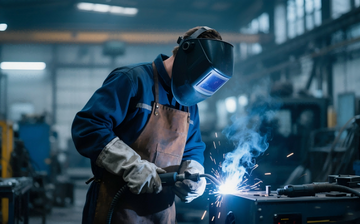Must-Read for Welders: Welding Safety Procedures and Welding Machine Maintenance Guide
Jun 14, 2025

In any welding operation, safety and equipment condition directly impact performance and personal protection. Whether you're a professional welder, repair technician, or a hands-on DIY enthusiast, this comprehensive guide to welding safety and machine maintenance is your must-have reference.

1. Welding Safety Gear: Your First Line of Defense
Electric arcs, hot metal splatter, toxic fumes, and high voltage are all serious hazards. Wearing proper PPE (Personal Protective Equipment) is non-negotiable:
Choosing the Right Welding Helmet
Opt for auto-darkening welding helmets with a reaction speed of ≤0.1ms and DIN 9–13 adjustable shade levels based on amperage. Arc flashes can cause photokeratitis—even from over 10 feet away.
Fume and Respiratory Protection
When working in enclosed or poorly ventilated areas, use an active fume extraction system instead of an N95 mask. Ensure strong ventilation to avoid inhalation of hazardous manganese oxides.
Full-Body Welding Apparel
-
Flame-resistant welding jacket (protects against heat and sparks)
-
Leather welding gloves (heat-resistant and cut-proof)
-
Insulated steel-toe safety boots (rated up to 392°F / 200°C, slip- and puncture-resistant)
⚠️ Real Story: A helper standing 10 feet away from a welding arc without proper goggles suffered UV-induced eye damage. Arc radiation has no “safe distance.”
2. 6 Essential Welding Safety Procedures
Sticking to standard procedures significantly reduces the risk of workplace injuries:
| Hazard Type | Required Safety Action | Accident Example |
| Electric Shock | Ground the welding machine at two secure points | Fatal electrocution in wet weather |
| Fire | Keep flammables at least 16 ft (5m) away | Oil spill ignited by arc splash |
| Explosion | Never weld sealed tanks or containers | Residual gas caused tank rupture |
| Toxic Fumes | Bake low-hydrogen rods at 662°F (350°C) | Inhalation of moisture-induced gases |
| Fall Hazards | No lifting before welds are structurally sound | Dropped equipment injured worker |
| Moist Environment | Use 24V safety voltage systems on wet ground | Worker electrocuted in puddle |
3. Welding Machine Maintenance: Prevent Failures, Save Costs
Pre-Operation: 10-Minute Checklist = 80% Failure Prevention
-
Grounding System Check: Use a multimeter to confirm ground resistance ≤4Ω. Sand rusted clamps to bare metal.
-
Cable Condition: Look for cracks, brittleness, or cable overheating. Voltage drop over 10m should be ≤2V.
-
Startup Diagnostics:
-
Fan noise should be stable and smooth.
-
Gas system: For MIG/TIG, ensure no pressure drop >0.05MPa in 1 minute.
-
Digital readouts: Compare open-circuit voltage to multimeter (tolerance ≤5%).
-
📌 Case Loss: A shipyard skipped gas leak inspection. Result: Porous welds from argon leaks led to $270,000 in rework costs.
While Operating: Monitor Critical Parameters
| Parameter | Ideal Range | Risk of Overlimit | Recommended Fix |
| Input Voltage | 380V ±10% | <342V damages IGBT modules | Install voltage regulator |
| Duty Cycle | ≤ rated spec (e.g., 60%) | Exceeding = overheating | Pause 15 minutes for cooling |
| Shielding Gas | 15–25 L/min (MIG) | Too low = brittle welds | Adjust pressure to 0.5 MPa |
Common Issues & Fixes:
-
Arc Instability: Check the contact tip bore (should be wire diameter + 0.2mm)
-
Overheating: Power off, open side panel, clean with compressed air at 45°, avoid direct vertical spray.
💡 Recommended: Install a circulating water cooling system for heavy-duty welders.
After Use: Deep Maintenance = 50% Longer Machine Life
3-Level Cleaning System
| Level | Task Description | Tools Needed | Frequency |
| Surface | Wipe off oil/grease | Neutral detergent, cloth | Daily |
| Intake | Remove and ultrasonically clean air filters | 40kHz ultrasonic cleaner | Weekly |
| Internal | Blow out circuit board dust | Anti-static air gun | Monthly |
Key Component Tips
-
Connectors: Apply electrical contact grease (e.g., Dow Corning DC-4), torque M10 screws to 15N·m
-
Gas Valves: Clean solenoids with anhydrous ethanol, test for leaks with soapy water
-
Moisture Control: Keep humidity ≤60%RH, use silica gel desiccants (replace when color changes)
💡 Protect your investment with a dedicated weather-resistant cover like the Arccaptain Fireproof Welding Machine Cover. It helps prevent dust, moisture, and thermal stress when stored outdoors or in damp environments.
4. Quick Welding Machine Troubleshooting Guide
| Symptom | Self-Check Steps | Likely Cause |
| Arc Instability | Measure input voltage, check grounding | Voltage drop or oxidation |
| No Output Current | Reset thermal protection, test transformer | Overload or burned coil |
| Frequent Overheat | Clean fans, inspect air ducts | Fan failure or blockage |
⚠️ Smelling burning plastic or seeing smoke? Shut down immediately—most welding machine failures come from ignoring early signs.
5. Don’t Ignore Built-in Safety Devices
-
Test grounding resistance monthly (≤4Ω)
-
Replace overvoltage protection devices every 2 years
-
Use diagnostic software to recalibrate digital welder feedback modules
Final Check: Your Welding Safety & Maintenance To-Do List
Today’s tasks:
-
Are your welding personal protective equipments up to code?
-
Is your gas, cable, and ventilation system working properly?
-
Have you scheduled routine machine maintenance?
Helpful Links:
💬 Remember: The thickness of your safety gear defines the length of your life. The frequency of your maintenance determines the health of your machine—and your wallet.
